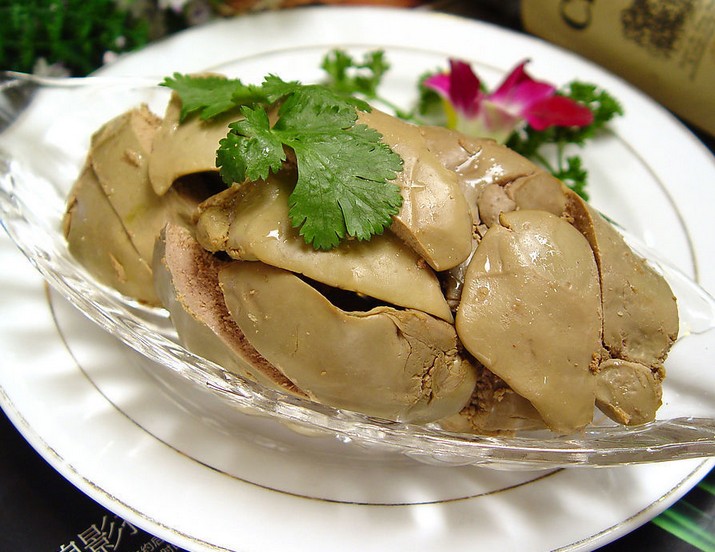(单词翻译:单击)
The lifting of the California ban against selling foie gras (the hyperfattened liver of geese or ducks, brought about by overfeeding the live animals) is pretty much a nonissue, except to point out that as a nation we have little perspective on animal welfare. To single out the tiniest fraction of meat production and label it “cruel” is to miss the big picture, and the big picture is this: Almost all meat production in the United States is cruel.
加州取消鹅肝(通过对活鸭、活鹅进行过度喂食造成的脂肪肝)禁令是个无关紧要的小事,顶多只是表明,我们这个国家对动物福利是没什么想法的。将肉类生产中这个微不足道的部分单独拿出来,称其为“残酷”,是不能体现全局的,而全局是这样:美国几乎所有的肉类生产都是残酷的。

The sale and production of foie gras was prohibited in California in 2012. Though the ban was widely ignored — foie gras was served for free in many restaurants and sold illegally in others — it’s now legal to serve it. (Production remains banned.)
加州在2012年发布了鹅肝的销售和生产禁令。不过,没什么人把这项禁令当回事——很多餐厅免费供应鹅肝,还有些餐厅在非法销售它——现在又可以合法供应了。(生产依然是禁止的。)
But so what? Foie gras is among the most overrated of luxury ingredients, ranking right up there with caviar and truffles. Done right, all three are delicious, but we can call them rich people’s food, and as such they’re not that important except to chefs who want to impress rich people or rich people who want to be impressed.
但那又如何?鹅肝是世界上最过誉的奢侈食材之一,和鱼子酱和松露并驾齐驱。会做的话,三种食材都很美味,但我们可以称之为富人食物,因此它们也就不那么重要了,除非是厨师想要取悦有钱人,或有钱人想要被取悦。
Of the three, from the point of view of pleasure, foie gras is the least important (many organ meats are more enjoyable), although it’s the easiest to produce and the least expensive. The best truffles are white, mostly Italian, difficult to find and stunningly pricey — upward of $1,000 a pound. The best caviar (beluga) comes from Iran, Russia and a couple of other countries with shores on the Caspian Sea; not only are prices comparable to truffles, fishing these endangered sturgeon is strictly regulated.
从愉悦的角度看,鹅肝是三种食材里最不重要的(很多器官要比它更美味),但却是最易于生产的,也是最不昂贵的。最好的松露是白色的,大多为意大利产,很难得,也贵得出奇——可以卖到1000美元一磅。最好的鱼子酱(白鲸鲟)产自伊朗、俄罗斯以及其他一些里海沿岸国家;它的价格堪比松露,而且捕捞作为濒危物种的鲟鱼是受到严格监管的。
Foie gras is not only available at relatively moderate prices (you can buy it now for something like $50-$75 a pound), but it’s also never out of season and produced domestically. And it’s a showpiece: Most chefs cook it not because they love it but to appeal to food snobs, who can report, “We went to XX last night and had the most amazing foie.” Right. (See this headline, which is vulgar but not wrong; don’t bother to read the “story.”)
鹅肝不但价格相对廉宜(现在每磅只要50到75美元就能买到),而且永远不会过季,又是本土生产。它是炫技用的:多数厨师会做,但不是因为他们喜欢,而是能吸引自命不凡的食评人,这些人接着会写:“昨晚我们去哪哪,吃到了美妙绝伦的鹅肝。”是啊。(看看这个标题,话糙理不糙;那‘报道’就不必看了。)
I’m not aware of a movement against killing sturgeon or other fish whose eggs can be used to make imitation caviar. This may be because fish are generally under-considered in the world of animal welfare, or because the most desired caviar comes from so far away or because it’s more precious than foie gras. But it also may be because caviar doesn’t invoke horrible images of gavage, as the process of overfeeding poultry is called — images that feature, not to put too fine a point on it, funnels.
据我所知没有人在发起反对捕杀鲟鱼或其他鱼籽可以用来模仿鱼子酱的鱼类。这可能是因为鱼类在动物福祉的世界里通常是比较受忽视的,或者因为最让人向往的鱼子酱来自太遥远的地方,又或者因为它比鹅肝还金贵。但也可能是因为鱼子酱不会让你联想起强行喂食的恐怖画面,也就是对禽类进行过度喂食的工艺——不想说太多细节,但画面中包含漏斗这样的东西。
It’s not a pretty thought, and it’s a less pretty sight. Of course, foie gras can also be produced without actually force-feeding because, like many animals — including humans and dogs — ducks and geese will happily eat anything that meets their standards. You don’t have to force them: They will stuff themselves anyway. So although the process may be “unnatural,” it’s not necessarily “torture.”
这个想法不怎么美好,而画面就更是丑陋了。当然,鹅肝也可以在不进行强迫喂食的情况下生产,和许多动物一样——包括人类和狗——鸭和鹅会欣然吃下一切符合它们要求的东西。你不用强迫它们:它们反正都会把自己往死里撑的。所以虽然这个过程会有些“不自然”,却不一定是“折磨”。
As to whether this is “good” for the animals, that’s another question. But let’s get our priorities straight. Statistically, foie gras is insignificant; according to a spokesman at Hudson Valley Foie Gras, one of the country’s main producers, the market in the United States involves just under 600,000 animals per year.
至于这对动物是不是有“好处”,就是另一个问题了。不过我们首先把优先级摆出来。统计数据上看,鹅肝是微不足道的;据美国主要鹅肝生产商哈德逊鹅肝公司(Hudson Valley Foie Gras)一位发言人称,美国鹅肝市场每年涉及的动物不到60万只。
My elementary math estimates that the United States chicken broiler industry kills more birds than that every single hour of every single day. (We produced an estimated 38.5 billion pounds of chicken in 2014, at an average of 6 pounds per bird.) Almost all of those birds are raised in conditions that range from unnatural to torturous.
以我小学水平的数学估算,美国肉鸡产业在每一天的每一个小时里宰杀的鸡都比这个多。(我们在2014年生产了约385亿磅鸡肉,每只鸡平均产出6磅肉。)而几乎所有肉鸡都是在不自然或带来折磨的环境中饲养的。
If you allow that the same is true of most animals raised in the United States, from dairy cows (which last year produced roughly 206 billion pounds of milk) to egg-laying hens (over 98 billion eggs) to cattle raised for beef (24 billion pounds), you are looking at an industry that produces cruelty on a scale that’s so big and overwhelming few of us can consider it rationally or regularly. And if you consider that cattle, for example, evolved to graze on grasses and are often fattened on grains — to which their digestive systems must then adapt — you might say that part of that industry’s routine is force-feeding.
如果你认为美国饲养的多数动物都是这样的情况,从奶牛(去年生产了约2060亿磅牛奶)到蛋鸡(超过980亿只鸡蛋),再到肉用牛(240亿磅),你看到的这个产业催生的暴行之庞大和普遍,已经令我们大多数人无法理性地、经常性地去思考它。比如我们考虑一下肉用牛,它们通过进化成为食草动物,但往往用谷物来育肥——这样一来它们的消化系统就必须去适应——你可以说产业惯例就是强迫喂食。
This is not to say a few thousand ducks and geese don’t matter; it is to say that it’s important to keep perspective. Although the plaintiffs used a federal statute (see the Poultry Products Inspection Act) to overturn the ban, and although that makes some animal welfare advocates uneasy, federal law is often used to trump state regulations, both good and bad. The legal experts I spoke to were wary, but did not see that this ruling, for example, set a precedent that might threaten California’s new egg-raising requirements, about which I wrote on New Year’s Day.
这并不是说几千只鸭或鹅不重要;而是说看到全局是很重要的。原告利用了一项联邦成文法(参阅《家禽产品检验法》[Poultry Products Inspection Act])来推翻禁令,这让一些动物权益倡导人士感到不安,但联邦法律经常成为对付州监管的杀手锏,有时是好事有时是坏事。和我聊过的法律专家对这项裁决有所警觉,但不觉得它创下了什么先例,比如能威胁到加州蛋鸡养殖新规的那种,这方面我在新年那天写过。
So, since this is not the last word on foie gras in California (or elsewhere), let’s stay tuned. If it’s ultimately and legally determined that foie gras production is cruel, inhumane or both, labeling it so would strengthen the argument that so are the current means of production for most industrially raised animals (and their products). This is best seen as a test case, not as a significant defeat or victory. Foie gras itself just isn’t that important.
所以,这并不意味着加州(或其他任何一个地方)鹅肝之争盖棺定论,我们要继续关注。如果最终在法律上裁定鹅肝生产是虐待,或不人道行为,或两者兼有,那么正式判定这一点会强化一种看法,即当前大多数工业养殖动物(以及相关产品)的生产所使用的手段,也都是这样。最好别把它看成是一次重大的失败或胜利,而是看成一个试验案例。鹅肝本身真的不那么重要。


